What a topic. Baseball fans, more than those of any other sport, have a tendency to play "what if?" games. I'm not sure exactly why that is, but it's clear that they do. Maybe it's because the intricacies of the game are easily accessible to the average fan, thus opening up GMs and managers to constant second-guessing. Or maybe it's because player performances are so thoroughly quantified with statistics that fans can more easily envision the impact of various roster changes. Nevertheless, this tendency manifests itself yearly in winter Hot-Stove Leagues, annual Fantasy Leagues, and even in the wide array of baseball simulation games available on the market.
One particularly twisted aspect of this "what if?" behavior is the continuing interest in the "All-Time Worst" trades. At face value, it appears to be nothing more than an unending self-abuse for fans of the victimized teams. But at a deeper level, it seems to confirm that deep-rooted notion present in all armchair general managers -- that they could do a better job if only given a chance at the reins. At least that's my take on it. After all, why does everyone always seem more interested in the details of the "worst" trades, but not the "best" trades? My guess is that the "best" trades don't really provide for the armchair managers the same affirmation that provided is by the "worst" trades.
To be objective in determining which trades were the worst, the accumulated, post-trade Total Player Ratings of the affected players were used. For those of you unfamiliar with this stat, it's enough to know that it is measured in "wins" and average players get zero. Below-average players get negative values, and the very best players can often reach 8-10 "wins" in a single, MVP-type season. To avoid having the late-career declines of players affecting the ratings, I excluded the below-average seasons. Of course, the players we traded away in these trades didn't have very many below-average seasons. In a ranking of "wins" that were traded away by the franchise, these are the worst trades in franchise history:
| Damage | Date | Trade |
| -38 wins | Nov. 29, 1971 | traded Joe Morgan to the Reds |
| -31 wins | Dec. 28, 1994 | traded Ken Caminiti and Steve Finley to the Padres |
| -24 wins | Dec. 10, 1991 | traded Kenny Lofton to the Indians |
| -24 wins | Jan. 22, 1969 | traded Rusty Staub to the Expos |
| -17 wins | Apr. 2, 1992 | traded Curt Schilling to the Phillies |
| -10 wins | Dec. 4, 1968 | traded Mike Cuellar to the Orioles |
| -10 wins | Dec. 2, 1971 | traded John Mayberry to the Royals |

|
The Mike Cuellar trade, however, was the beginning of a series of abominably bad trades made by the Houston GM. I cannot fathom why anyone in 1968 would trade Cuellar for Curt Blefary, but I'll try to figure it out. Even though Cuellar had posted a nice 2.74 ERA, perhaps his 8-11 record was considered a sign of decline for the 31-year-old lefty. After all, Cuellar had posted a 16-11 record the year before and the team had a crop of young, talented pitchers in the rotation. Maybe there was something personal about Cuellar that I have not heard about. Or maybe Richardson saw something special in the 24-year-old Curt Blefary. Either way, Cuellar was traded for Blefary, who was coming off of a disappointing 15 HR, .200 average season. Blefary's superior performance in 1967 (22 HR, .242) may have factored into the decision as well. But keep in mind that Cuellar's ERA totals from 1966-1968 were an impressive 2.22, 3.03 and 2.74. His ERA in 1966 was a team record which stood for 20 years until tied by Mike Scott in 1986.
How did the trade turn out? Blefary turned in a 12 HR, 67 RBI, .253 season for Houston, which can be considered an average performance at best. He was promptly traded in the next off-season to the Yankees for Joe Pepitone, who turned out to be a complete bust.
Cuellar, of course, continued his fine pitching but was provided with generous run support from the offensive powerhouse of the Orioles. As a result, his won-lost records over the next SEVEN seasons were 23-11, 24-8, 20-9, 18-12, 18-13, and 22-10. Keep in mind that up until 1999, no Astro pitcher had won more than 21 games in a season in the history of the franchise, yet Cuellar accomplished this feat three times with the Orioles. It's also notable that Cuellar reached the World Series with the Orioles in each of the three years immediately following the trade.
With the rise to prominence in 1969 of Astro pitchers Larry Dierker, Don Wilson, Denny Lemaster, and rookie Tom Griffin, it's not hard to imagine how well the 1969 staff would have performed if Cuellar had been in the rotation as well.
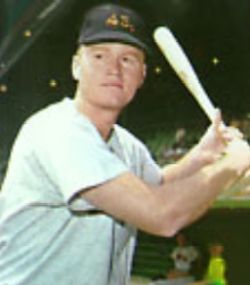
|
Regardless of the arrangements, this deal should never have been made, even without the benefit of hindsight. Clendenon was a 32-year-old first baseman, who had had several good offensive years with the Pirates. His performance had been declining for several years, culminating with a 17 HR, .257 avg performance in 1968 in which he led the league with 163 strikeouts. Given his age, there was no reason to think that his career would rebound.
Staub, on the other hand, could play first base and the outfield and was only 24 years old in 1968. He was named the team MVP in 1966 and 1967 and played 161 games at 1B in 1968. His batting averages from 1966-68 were .280, .333, and .291. Remember, this was done in an extreme pitcher's park during a pitcher's era. His .333 average in 1967 was a team record that stood for 27 years (Bagwell, 1994) and his 44 doubles that same year lasted as long before being tied (Biggio, 1994). The only drawback to Staub was that his HR output had dropped to 6 in 1968. Keep in mind, however, that he was only 24 years old and had represented the Astros in the previous two All-Star Games. The power differential between Staub and Clendenon may have been appealing to the club but, according to Larry Dierker, one motivation for the trade was that the team suspected Staub had a congenital ankle problem and would not have a long career.
Regardless, the trade could not have turned out worse. Clendenon didn't report to Spring Training, Alou was never more than a 4th outfielder, and Billingham turned in 3 mediocre seasons (ERAs of 4.25, 3.98, 3.39) before being shipped to Cincinnati in the Joe Morgan deal.
Once Staub escaped the suffocating confines of the Astrodome, he suddenly found his power stroke and his ankles never affected his performance. In Montreal, he became known as "Le Grande Orange" and was one of the league's best-hitting outfielders, stroking 78 homers and hitting .294 over the next three seasons. He continued his All-Star ways, with appearances in all three of his years with the Expos. He then spent many, many productive seasons for the Mets and Tigers, and reached the World Series with the Mets in 1973. He finished his career with 292 home runs, more than any Astro in history except Jeff Bagwell.
How could things have been different? Well, they could have kept Staub to play OF in 1969 and tried two different, promising youngsters at 1B. Bob Watson was 23 and had been given a short trial in 1968, but may not have been ready for the bigs. Nate Colbert was a promising 22-year-old OF/1B that had slugged his way through the minors and been given a brief 20-game trial in 1968. It would not have been unreasonable to protect him in the 1968 expansion draft in anticipation of the need for a first baseman. Instead, San Diego selected him and he slugged 127 home runs for the Padres over the next four seasons. Just imagine the 1969 team with Colbert at 1B, Staub in the OF, and Cuellar in the starting rotation. I know hindsight is 20/20, but I still think I'm gonna puke.
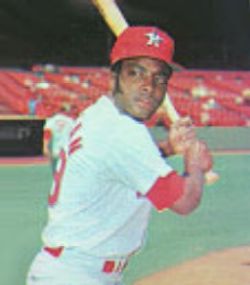
|
The Reds, on the other hand, had veteran Lee May at 1B. May was a feared slugger who had clubbed 39 homers in 1971 and could be reasonably expected to continue his slugging ways. Houston GM Spec Richardson saw May as an opportunity to solve the team's power shortage so he sent Morgan, Menke, Jack Billingham and Cesar Geronimo to Cincinnati in exchange for May, Helms and utility infielder Jimmy Stewart.
Additional speculation about this trade centers around management's desire to "split up" Morgan and Jim Wynn, who were friends and party-goers and may have been considered a risk to get into trouble. If true, that's a really bad reason to trade away a very productive second baseman. Since Wynn was the bigger power-hitter, the choice may have been made to keep him at the expense of Morgan.
What happened after the trade? May and Helms had a good year or two, but never played to their expected performance levels. May was later traded for Enos Cabell and Helms was eventually dealt for Art Howe. Morgan, however, went on to have a Hall of Fame career in Cincinnati highlighted with two MVP awards and two World Series championships. He scored over 100 runs for six consecutive seasons after the trade and finished with 268 career home runs, which is astounding for a second baseman from that era and more than any Astro in history except Jeff Bagwell. He is generally considered to be the greatest second baseman of this half-century and was a key component to the Big Red Machine.
In hindsight, what could have been different? Aside from not making this disastrous trade, the Astros could have easily solved their 1B problems by playing lefty John Mayberry regularly. After all, the 1970 media guide lists Mayberry as "probably the highest-regarded prospect in the Houston organization". Instead, he was traded away three days after the Morgan trade to Kansas City, where he subsequently flourished. Although the Astros and the Reds had identical records in 1971, the two teams diverged rapidly after this trade. Over the next five seasons, Cincinnati won four divisional titles and two world championships. They also never won fewer than 95 games in a season, and that minimum total occurred in the 1972 "lockout" season which was shortened by 8 games. During the same period, the Astros finished in a respectable 2nd place in 1972, played .500 ball in 3 other seasons, and cratered into dead last in 1975 with a all-time franchise worst 64-97 record. This happened to be the same year that Morgan earned his first MVP award.
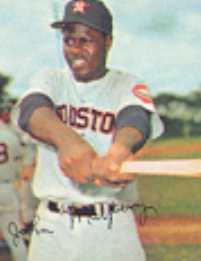
|
Mayberry was 22 years old at the time of the trade and had torn through the Astros minor league system. He struggled, however, in two cameos in the majors and was apparently given up on in favor of the veteran May. At Kansas City, however, he was given an opportunity to play every day and subsequently thrived. Over the next four seasons, he swatted 107 homers and drove in 100 runs three times. This was back in the seventies, when 100 RBIs really meant something.
As importantly, Mayberry had the plate discipline to draw walks. Unlike Lee May, who posted OBP of .344, .315 and .298 in his three seasons with the Astros, Mayberry posted OBP of .396, .420, .359, and .419 in his first four seasons with Kansas City. He led the AL twice in walks and once in OBP. Three of his first four seasons in KC were superior to the best season Lee May had in Houston. Mayberry's best season was in 1975, which coincidentally was Joe Morgan's first MVP season and also the worst year in franchise history for Houston. In 1976, his last season with the Royals, Mayberry was one playoff victory away from reaching the World Series when his team fell short against the Yankees in the ALCS. Mayberry finished his career with 255 homers and a .253 average, but was most effective in those first four years after the trade. What's really sad is that the Lee May acquisition is what made Mayberry expendable. Since they were both slugging first basemen, their seasons are directly comparable.
In exchange for this promising young slugger, the Astros received Lance Clemons and Jim York. Clemons never pitched a single inning for Houston while York provided four mediocre years in the bullpen with a career ERA of 4.19 as an Astro. Chalk up another bad trade to Spec Richardson, who should probably be remembered as the single man most responsible for the continued mediocrity of the organization from 1966-1978. He was replaced by Tal Smith as GM after the disastrous 1975 season, and the organization won its first division title five years later.
This trade is brought up a lot as a really bad trade, but I have to admit that I have a lot of sympathy for Houston GM Bill Wood on this one. After the 1991 season, the decision had been made to move catcher Craig Biggio to second base to protect his knees and lengthen his career. We all know now what a GREAT idea that was, so the organization deserves credit for that.
Of course, this created a void in the catcher position and the organization had only Carl Nichols, Scott Servais and Tony Eusebio available to step up. Apparently none of them were considered adequate, and Eddie Taubensee in Cleveland caught Wood's eye. Eddie Taubensee was 22 years old in 1991 and had played 91 games in AAA before being called up as a reserve. In AAA, the left-handed Taubensee had shown the ability to hit for average (.310) and power (13 HR in 287 AB). This was apparently enough to sell Wood and he arranged the deal with Cleveland.
Kenny Lofton was a very promising CF prospect in the Houston organization, showing the ability to get on base a lot and to steal second almost at will. He had been given a cameo in 1991 and hit only .203 in 74 at-bats. It's very important to note that CF Steve Finley has just had just completed a fine rookie season (.285, 34 SB) and was outstanding defensively, so Lofton was certainly blocked by Finley and therefore expendable. Considering that the organization had several other OF prospects (Eric Anthony, Karl Rhodes, Mark Davidson), Wood possibly remembered the failed "Gerald Young" experiment and pulled the trigger on the deal. Of course, of all the speedy, slap-hitting center fielders brought up in the organization's history (Tony Scott, Gerald Young, Brian Hunter), only the future stars were traded away. See the 1994 Ken Caminiti trade to learn of Finley's fate.
Given the circumstances leading up to the trade, I can understand Wood's decision. There's no way he could have reasonably predicted Taubensee's mediocre career and Lofton's rise to super-stardom. What has Lofton accomplished in the seven seasons since the trade? He's batted .313 during that span with an impressive .387 OBP. He's appeared in four All-Star games and led the AL in stolen bases from 1992 to 1996. In fact, his 408 career stolen bases would be 2nd on the Astros all-time list, and he's eclipsed the Astro single-season record (65 SB) three times in his career. And, not coincidentally, he reached the World Series with the Indians in 1995. Since he's still playing and performing at a high level, this trade gets a little worse with each passing year.
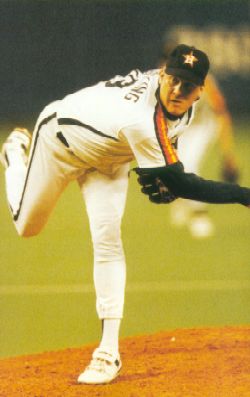
|
Entering the 1992 season, Curt Schilling was a 25-year-old pitcher that had shown promise but was plagued with control problems. Groomed as a starter in the minors, Baltimore pitched him exclusively out of the bullpen in 1990 and Houston continued that pattern in 1991. Schilling had not been particularly impressive for the Astros, posting a 3.85 ERA in 75 innings. He did strike out 71 batters, but his 39 walks were unacceptably high. The details leading up to the Spring Training trade for Jason Grimsley were not known to me, so I'm going to repeat a story about this I've heard from credible sources. Apparently Schilling showed up in Spring Training overweight and with the attitude that he'd already made the team. His complaints about working out of the bullpen along with his undisciplined work habits certainly rubbed GM Bill Wood the wrong way. In an attempt to send a message to Schilling and the team, Wood hastily traded the talented pitcher to Philadelphia for Jason Grimsley and nobody was really sad to see him go.
Grimsley never amounted to much, but Philadelphia quickly plugged Schilling into their porous rotation and reaped immediate benefits from the attitude-adjusted Schilling. This former prima donna won 14 games, pitched 226 innings with a 2.35 ERA, and led all NL starters in opponent's batting average and opponent's OBP. In 1993, he won 16 games and helped lead the Phillies to the World Series. After struggling with injuries over the next three years, Schilling recovered and won 58 games over the past four seasons with Philadelphia and Arizona. He also became the first pitcher since J.R. Richard to strike out 300 batters in consecutive seasons. Like Kenny Lofton, Schilling is still performing at a high level, making this trade look worse with each passing season.

|
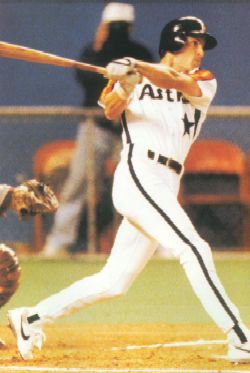
|
As with all bad Astro trades, World Series appearances and MVP awards often result for the team dealing with the Astros. The Padres were no exception in this case. Caminiti slugged 121 homers over four seasons in San Diego, winning the MVP in 1996 with a 40 HR, 130 RBI, .326 performance. Finley also had the best seasons of his career, having a monster season in 1996 with 30 HR, 95 RBI, and a .298 average. This dynamic duo also totaled 3 All-Star appearances and 5 Gold Gloves during their 4-year stay in San Diego. In 1996, the Padres won their first division title since 1984 and reached the World Series in 1998. During the 1996 monster year for Caminiti and Finley, Houston finished 6 games out of first place. In 1998, Houston was eliminated from the playoffs by the Padres.
Houston's results from the trade were mixed. Derek Bell established himself as the everyday RF, but his hot-cold performances alternately drew praise and ire from fans until he was finally dumped in the Mike Hampton trade with the Mets. Ricky Gutierrez struggled until establishing himself in 1998 as an everyday SS with his consistent, if unspectacular, play. The Astros made no attempt to sign his as a free agent, preferring to take their chances with Tim Bogar. Phil Plantier was expected to slug his way into the everyday lineup but was quickly (and quietly) dealt back to San Diego after 22 games of lackluster play. Craig Shipley played half a season at 3B in 1995 before returning to the Padres as a free agent. Two pitchers received in the trade, Doug Brocail and Pedro A. Martinez, were also unimpressive and neither spent more than two seasons with the club.
Caminiti and Finley have begun their inevitable career declines and are no longer making this trade look worse with each passing season. Caminiti has came home to play in Houston, but spent more time on the Disabled List than in the lineup. After signing a lucrative contract to finish his career with the Arizona Diamondbacks, Finley recorded two of the finest seasons of his career. In fact, he is on the verge of reaching 200 career home runs.